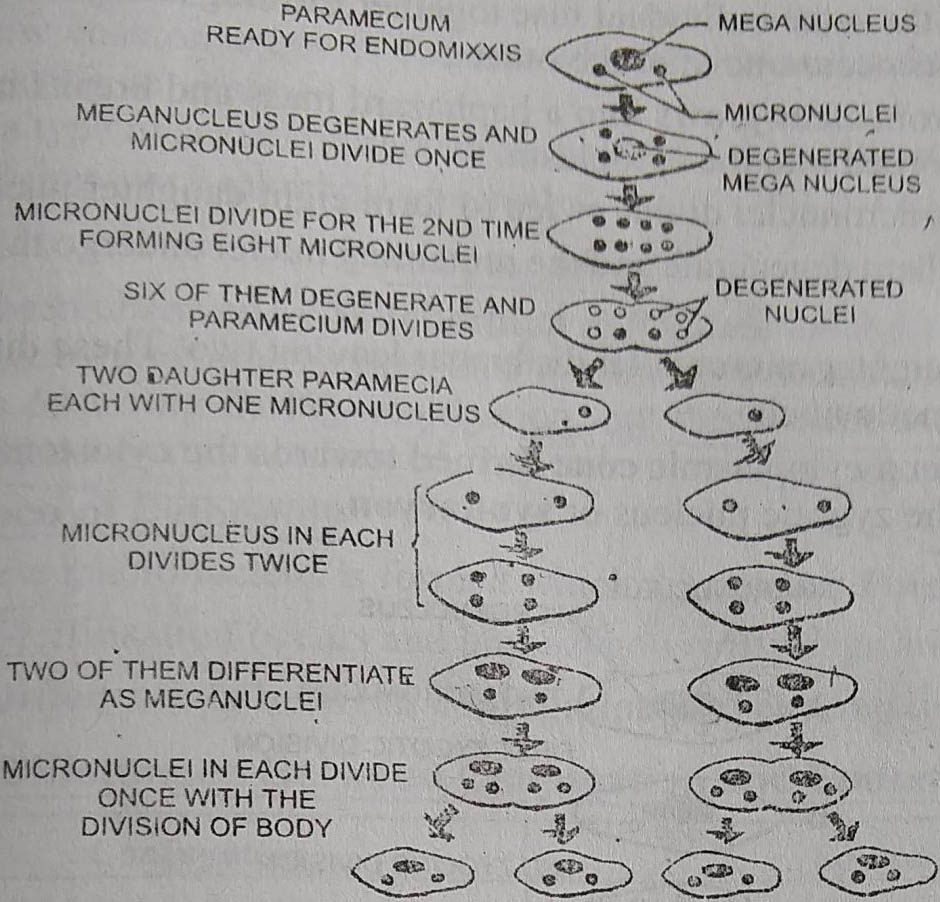Q.5. What is nuclear reorganisation? How it takes place in Paramecium? Describe autogamy, cytogamy, endomixis and hemixis in Paramecium.
Ans.5. Degeneration of old macronucleus and formation of a new one by the fusion of micronuclei is called nuclear organisation.
During binary fission, the macronucleus divides by amitosis in which chromosomes are distributed at random in the daughter macronuclei. The genic balance of macronucleus is disturbed due to repeated binary fission. This results in less vigour and vitality of the daughter individuals. This reduces the rate of binary fission. After passing through a certain number of asexual generations, the daughter paramecia die for want of nuclear reorganisation. Replacement of such a macronucleus becomes necessary to rejuvenate the aging paramecia.
1. Endomixis
Endomixis is nuclear reorganisation followed by the division of body within a single individual, with no nuclear exchange or fusion. It occurs only in the absence of conjugation and has been described by Woodruff and Erdmann in a binucleate species, P. aurelia. The process can be distinguished into the following steps:
1. The macronucleus disintegrates and is absorbed in the surrounding cytoplasm.
2. The two micronuclei divide twice forming eight daughter micronuclei.
3. Six of them disappear leaving two micronuclei.
4. The animal with two micronuclei divides by transverse binary fission and two daughter individuals each with one micronucleus are formed.
5. Micronucleus in each daughter Paramecium divides twice.
6. Of these four nuclei, two enlarge to form two macronuclei and two micronuclei.
7. The micronuclei in each daughter individual again divide accompanied by the division of body.

Thus four daughter paramecia are formed from a single parent and each possesses one macronucleus and two micronuclei.
Significance of Endomixis
1. Multiplication : As a result of endomixis four individuals are formed from a single parent.
3. The endomixis is regarded as a substitute for conjugation since it occurs only when conjugation is prevented or delayed.
2. Hemixis
Hemixis was described by Hartman and is confirmed by Diller in P. aurelia. It is a simple phenomenon of nuclear organisation. Micronuclei remain inert and macronucleus gives off small fragments of chromatin material which are absorbed in the surrounding endoplasm. The remaining macronucleus and the micronuclei behave normally.
The hemixis is considered to be an act of purification on the part of macronucleus and the chromatin balls are regarded to contain accumulated waste products.
Significance
This is a type of nuclear reorganisation in which old macronucleus is purified by discarding off fragments of chromatin material.
3. Autogamy
Autogamy is a type of nuclear reorganisation occurring in P. aurelia. It resembles conjugation but occurs inside the single individual. The two micronuclei of the same individual fuse together forming the synkaryon. The following events occur one after the other :
1. The macronucleus grows into a haphazard mass and breaks into pieces to be absorbed into the cytoplasm.
2. The two micronuclei divide twice to form eight daughter nuclei.

3. Some of them degenerate and the remaining nuclei undergo third mitotic division
4. All the daughter micronuclei disappear leaving two. These differentiate as the gametic nuclei. 5. These enter a cytoplasmic cone formed towards the cytostome and fuse forming the zygotic nucleus or synkaryon.
6. The synkaryon divides twice. The resultant four nuclei differentiate as two macro and two micronuclei.
7. The cell body and the micronuclei divide simultaneously forming two daughter paramecia.
1. A new macronucleus is formed which rejuvenates Paramecium by increasing its vitality.
2. It is a type of sexual reproduction in which self fertilisation takes place involving two haploid gamete nuclei.
4. Cytogamy
It has been observed by Witcherman in P. caudatum that two individuals fuse together by their oral surface for some time. Their nuclei undergo similar changes as occurring during conjugation, but the nuclear exchange fails to occur and synkaryon is not formed. The individuals then separate and divide.
Significance of Cytogamy
1. A new macronucleus is formed which rejunevates Paramecium.
2. Self-fertilisation occurs and homozygous offsprings are produced.
BSc 1st Year Lower Non-chordates Paramecium Sample Model Practice Question Answer Papers
BSc 1st Year Sample Model Practice Mock Test Question Answer Papers